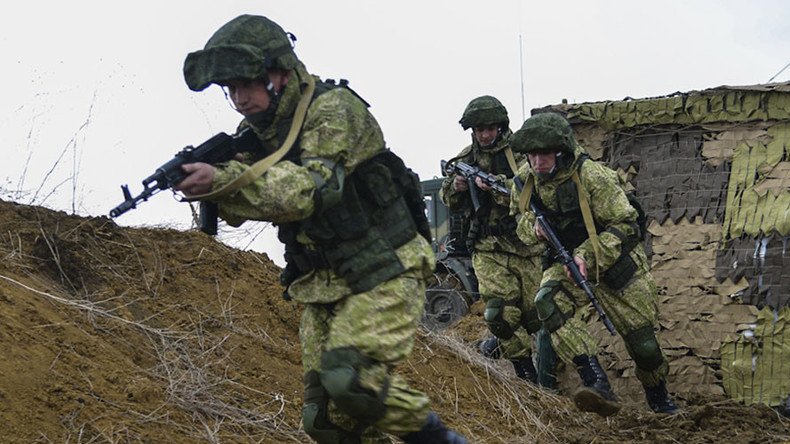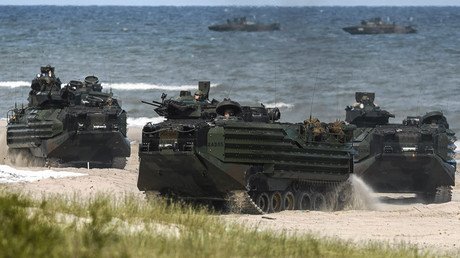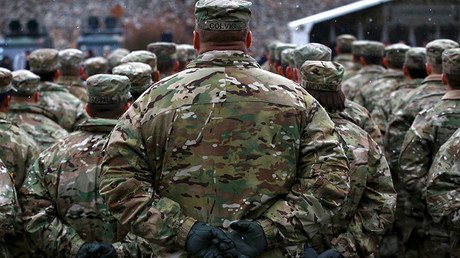Airborne troops, Mi-28s & fleet: Massive military drills kick off in Crimea (VIDEO)

Large-scale military exercises involving several Russian airborne units as well as the Air Force and a part of the Black Sea Fleet have begun in Crimea, the commander of the Russian Airborne Troops told Russian media.
An air assault division from southern Russia and two airborne brigades from Russia’s central and far-eastern regions are taking part in the drills alongside with a part of the Black Sea Fleet and the 4th Army of Air Forces and Air Defense of the Southern military command, Colonel General Andrey Serdyukov, the head of the Russian Airborne Forces, told journalists.
Serdyukov said that 2,500 soldiers and 600 pieces of military equipment are taking part in the exercises, which would become the first military drill of that scale in Crimea after its re-unification with Russia.
“For the first time in history of the Russian Army, as part of the airborne troops exercise, three formations were simultaneously alarmed and partly deployed to Crimea with weapons and hardware,” Serdyukov said.
READ MORE: Russian strongman moves 312-ton port crane to mark 3rd Crimea reunion anniversary (VIDEO)
The drills are conducted in response to “the growing terrorist threat,” he added. According to Serdyukov, such exercises are necessary as the airborne troops could potentially be used as rapid deployment forces in various regions of the world as part of crisis resolution operations.
The drills are expected to involve amphibious and airborne assaults as well as fire courses and training in offensive and defensive operations. Serdyukov said that the troops would train in defeating various militant groups as well as regular forces of a hypothetical aggressor.
The drills have begun as a US-led battle group of over 1,100 soldiers has been scheduled to be deployed to Poland in early April. The battalion’s commander, US Army Lt. Col. Steven Gventer, tied the deployment to deterring possible Russian “aggression in the Baltics and in Poland,” while another high-ranking officer said it was “not the entirety of NATO’s response” to Moscow over reunification with Crimea and the alleged role in the eastern Ukrainian crisis.
READ MORE: ‘Fully ready to be lethal’: US-led NATO battalion to be deployed to Poland
Earlier in February, US troops were deployed to Bulgaria to boost NATO presence in Eastern Europe. Tanks and hardware accompanied by another 500 American troops also arrived to Romania.
Russian Deputy Foreign Minister Aleksey Meshkov expressed Moscow’s concerns over the increased risks posed by the NATO buildup in the Eastern Europe to Russian security. “This deployment is of course a threat for us,” Meshkov said in February in an interview with RIA Novosti while giving assurances that Russia will be able to protect its citizens.
In July 2016, NATO members agreed to the “biggest reinforcement since the Cold War,” posting four multinational battalions to Estonia, Latvia, Lithuania and Poland. In January, 2,800 pieces of US military hardware, including US Abrams tanks, Paladin artillery, Bradley fighting vehicles and 4,000 troops arrived in Europe as part of the buildup.
NATO members Germany, Canada and Britain are also contributing to the significant NATO forces’ buildup in Eastern Europe and are sending battalions of up to 1,000 troops each to Estonia, Latvia and Lithuania.
Since the spring of 2014, NATO warships, including missile cruisers from the US and other allied nations, have been patrolling the Black Sea on a rotational basis. NATO explained its increased activity near the Russian borders by the need to reassure its allies following Russia’s reunion with Crimea in March 2014.
Russia’s envoy to NATO, Aleksandr Grushko, has been warning that the alliance is pushing the world into a new arms race by its buildup in the region.
Grushko on Monday said NATO’s increased military activity, including frequent drills on Russia’s border, “creates new reality,” which could lead to a “spiral of an arms race, which is very difficult to escape.”














